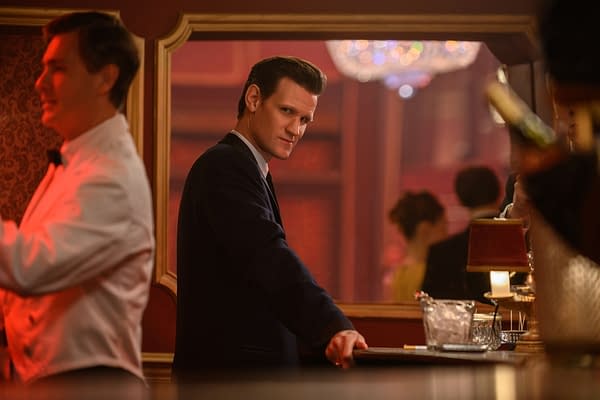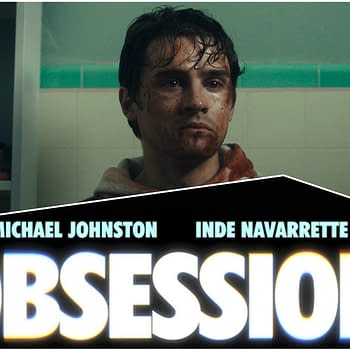Posted in: Focus Features, Movies | Tagged: Focus Features, last night in soho, movies
Confronting the Real Taboos in Last Night in Soho [SPOILERS]
Last Night in Soho is proving to be more or less well-received, but some people have issues with it, and for very good reasons. However, the marketing for this movie has done a pretty good job of excluding most of the third act and any footage we do see is out of context, so no one really knows what they are getting into. That third act is the problem, and the reveals made in that act and the second act are the ones that can be seen as a bit off. To get into that, we're going to have to throw up a massive spoiler warning. If you haven't seen Last Night in Soho and you want to go in not knowing anything, stop reading this article now and go see the movie. If you have seen the movie or if you don't care about spoilers, let's proceed and talk about this whole thing.

As our protagonist Eloise continues to see more and more of Sandie's life in her dreams, it becomes apparent that the idealized version of the city that Eloise thought existed in the 1960s was not the world she is dreaming now. Jack, who said that he would be Sandie's manager, soon becomes her pimp, and we watch as Sandie becomes a prostitute under Jack's watchful eye. Eloise seems very disturbed by this, and the visions of the dreams become more and more like a nightmare than a dream. On Halloween, a slightly drunk Eloise sneaks John into her room, and they are getting intimate when she has a waking vision. This time, she screams as she sees Sandie being killed by Jack. Eloise's landlord, Ms. Collins, comes running up and chases John out of the room.
In the latter half of the second act and leading into the third act, Eloise is haunted by specters of faceless men who look like Sandie's clients as she tries to find out more about Sandie to tell the police who she was, so Jack can finally go to prison. There is an older man at the pub Eloise works at that she believes is Jack in the present day. However, after the man is hit by a car in front of Eloise, we find out he is a former vice cop who tried to help Sandie. Eloise and John go back to her room, and Eloise tells Ms. Collins that she needs to leave, but Ms. Collins reveals herself to be Sandie. She says that she did die in that room, but not literally. She killed Jack and started killing all of her clients, hiding their bodies in the walls and floors.
Sandie then drugs Eloise to kill her, and eventually, there is a confrontation between her and Eloise after Sandie stabs John and leaves him to die. As the specters of Sandie's dead clients break through the walls and floors, it becomes apparent that they are not trying to hurt Eloise — they want her help. Sandie walks into the room to see these ghosts standing around Eloise. She and Eloise talk about how the men deserved it, and Eloise runs out of the now-burning house as Sandie stays behind in the room in flames. After her final fashion show, Eloise sees Sandie's reflection in a mirror, and she winks and blows a kiss.
![Confronting the Real Taboos in Last Night in Soho [SPOILERS]](https://mlpnk72yciwc.i.optimole.com/cqhiHLc.IIZS~2ef73/w:600/h:400/q:75/https://bleedingcool.com/wp-content/uploads/2021/09/4139_D059_00186_RC1631064144.jpg)
There is a lot of unpack here, including the fact that the movie established the connection between Eloise and Sandie, not Eloise and the clients, but that is the internal logic of the film not making sense. The first thing we need to talk about is how Last Night in Soho looks at sex work. Are there people in sex work that don't really want to be there and don't enjoy their jobs? Absolutely and those people should be removed from that situation at all costs. Sandie is one of the people in that situation. However, all sex work is not bad. In the age of OnlyFans and many regular people getting into sex work to pay the bills, the trope that sex work will not only lead to misery but ultimately break a person is old and antiquated. Sex workers constantly face some of the worst stigmas. They can be kicked out of their homes without notice, they can be denied mental and health services, they could lose their banking, and as adult performer Riley Reyes said in this video, "let me tell you how hard it is to find a gynecologist who will have an honest conversation with me."
Last Night in Soho not only demonizes sex work, but it also seems to be the thing that the movie blames for Sandie turning into essentially a serial killer. Sandie isn't shown to have any murderous and dark tendencies before she meets Jack and is forced into prostitution. She is keen to make her career as a singer a reality, and she is confident in herself, but that doesn't mean she was one bad day away from becoming a murderer. The decision for Sandie to kill and who she kills is based entirely on the fact that she is a sex worker. That frames the entire industry as someone that will break someone when to most sex workers; it's just a job. It's something they do to pay the bills and support their families the same as I am writing this article or you do going to your 9-5 job.

If the demonization of sex work wasn't bad enough, Last Night in Soho takes it a step further. Are there men who pay for sex who are terrible people? Of course, there are assholes in literally any job where you interact with the public in any way. However, when Eloise and Sandie are having their final confrontation in the burning room, they both agree that the men deserved to die. People who pay for sex do not deserve to die. There is absolutely no shame in paying for sex provided everyone involved is a consenting adult, payment is exchanged, and no personal boundaries are crossed. The idea that Sandie doesn't face any sort of justice for what she did, she chooses to remain in the room that is burning down, and the fact that both her and Eloise agree that the men deserved it doesn't even make sense in the context of the movie. The spirits of the men were asking Eloise for help so they could rest, and she still thought that they deserved to die? One could argue that Jack "deserved it," but the other men were just hiring a prostitute. They didn't know that they were harming her by hiring her. They were just customers.
The entire movie seems to have a very anti-sex message throughout. As mentioned in my review, the character of John is put in a highly precarious situation the night that Eloise sees the vision of Sandie dying. To anyone else, it would look like he, a black man, was attempting to sexually assault a white woman. That is the sort of thing that gets black men thrown into prison for life, and the movie never takes the time to examine that angle at all. If you want to learn more about the race angle of this character, I encourage you to seek out voices better than mine to cover it [sources: one, two, three]. There isn't a single sexual encounter in this movie that is presented in a positive way. The film opens with Eloise having to watch her roommate hook up with a guy in their shared room. It's the catalyst for why she moved out of the dorms and into Ms. Collins's room. The encounter between Eloise and John goes wrong; we never see anything romantic between Sandie and Jack, only the times when she is working with clients. In fact, the only encounter that is in any way sexual in the movie is the movie where Sandie and Jack first meet, and he kisses her on the neck. Eloise wakes up with the same hickey on her neck, but every other encounter in this movie is seen as a negative.

Was it Edgar Wright's intention to demonize sex workers and the men that use sex workers? Probably not; he was likely leaning more toward the angle that the most dangerous thing to a woman is a man. That is why the personality differences between Jack and John are so apparent, even if it means that John gets almost no personality or internal life outside of Eloise. However, these tropes about sex work, the people who do it, and the people who partake in it are harmful. They enforce the kind of stigma that forces sex workers to remain with dangerous pimps instead of being able to advocate for themselves. They enforce the idea that all sex workers need to be "saved" when a decent portion of them want to do their jobs. Much like all complicated topics to discuss, the more we demonize these things, the more they stay in the shadows where the really bad things happen. If you want to keep sex workers safe, you need to give them the same rights as any other worker.
Sex work is just work, like any other job, and the people who partake in sex work are just customers. The idea that any of these people are doomed to lose their minds or deserve to die isn't going to help save or protect anyone. Total decriminalization is so important if you want to help and protect sex workers. That is what we should be talking about, not enforcing dangerous stereotypes that will only make things worse for people who are just trying to live their lives. Last Night in Soho is currently in theaters now.













